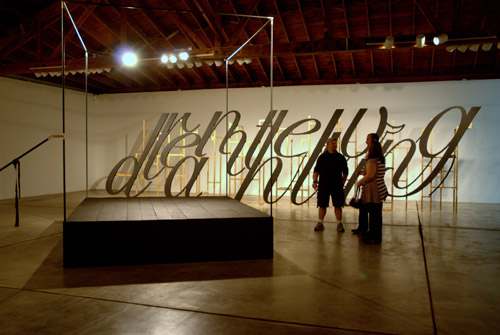Tannaz Farsi is an assistant professor in sculpture at the University of Oregon School of Architecture and Allied Arts. Her recent exhibition, “Losing Themselves in a Distance to Far Away Heights” opened October 8, 2011 at Portland’s Disjecta Interdisciplinary Art Center. The show is on exhibit until November 5, 2011 at Disjecta, 8371 North Interstate, Portland, Oregon.
Plans to show Farsi’s work had been announced in January 2011 when Disjecta’s curator-in-residence, Jenene Nagy detailed her goal to present “risky, challenging work not usually found in mainstream museums or commercial galleries” with the selection of five West Coast artists. Nagy’s curatorial intent was to inspire regional conversation around contemporary art. The five artists Nagy selected show an immersion in the concerns and language of the contemporary art world.
“Losing Themselves in a Distance to Far Away Heights” is Tannaz Farsi’s first solo exhibition in Portland. In the exhibit, Farsi addresses “what does it mean to live the dream?” from the Iranian, Canadian-Iranian, and Iranian-American perspective. Farsi asked her correspondants what it means to live the dream, their nationality, ethnicity and country of residence in hopes that something could be articulated through their answers that would address ideas of nationalism and cultural identity. Farsi also thinks that the idea of the American dream is complex; one marked by consumer culture, ideals of morality and normalcy, and the other of freedom to exist without constant state surveillance and yet another of component of Martin Luther King, Jr.’s dream ( a speech Farsi references in this work). She says, “Part of the lore surrounding the King speech is that Mahalia Jackson shouted out: ‘Martin, tell them about our dream.’ And, that part of his famous speech organically grew out of this request. I wanted to more show the dream’s complexity as well as the complexity of ethnicity and illuminate the fact that most of the people that have left Iran in the past 33 years fall under the category of exile or refugee.”
Farsi, herself an Iranian-American, conducted conversations via email with friends, relatives, and connections she was given by friends and family to individuals unrelated to her.
“The soul of that life is still with me…”–Gmail excerpt from Keyvan Mahjoor, Canada
A portion of Farsi’s exhibit is her record of communication, via gmail, with Iranians, Canadian-Iranians, and Iranian-Americans and their responses to her query: “what is ‘living the dream according to you'”? The Persian responses have been printed on large paper, the emails preserved in their original gmail form displayed poster size and hung side-by-side. Some emails are still in their native script beautifully left untranslated. One email is accompained by an image and words of the artist proclaiming, “I paint my dream and I live my dreams….” (Gmail excerpt from artist, Keyvan Mahjoor, Canada) The viewer is impressed by the simple eloquence of the writing: “the soul of that life is still with me….” and, “living my dreams means society respect me, my love, my privacy, and my need of freedom.” (Gmail excerpt from Shohreh Entekhabi.) Farsi says she was also using the gmail “to capture another form of tracking–to see what advertising suggestions would pop up in response to individual conversations.”
Tannaz Farsi seems to have a fascination for the relationship of objects as conflicting forces. That intrigue is well represented in “Losing Themselves….” The exhibit provides a compass directing us to gain a certain comfort in visually recognizable poem-like text that has been coupled with an elegant architectural and sculptural vastness occupying the reservoir-like space of Disjecta. Our vision of both the textual component juxtaposed with the structural staging reassures us with the familiar and challenges us with the unexpected.
“Living the Dream”
Farsi’s significant built installation curves and undulates in perfectly crafted cursive English words, so gentle and flowing in form yet the surface denies this soft delicacy with a tactile bite at once gritty, harsh and starless black. Farsi compels us to question the dicotomy of this pairing: it provides an attainable understanding with words and language we are familiar with and then snatches it away with a vastness and a jumbled complexity that leaves one struggling. Even the framework here, painted a gilt gold, is linguistically scaffold-like: how would one begin to surmount such skeletal casements? The shadows cast by this piece are just as entrancing from the front as from the back lending a voice to this persuasive sense of aching yearning, boundless struggle, and disappointment. It is a graceful statement of contemporary Iranian cultural experience.
The materials Farsi blends into her work are similar to memories echoing the very same sentiments her emails project to us: that which both represents the tension and binds felt by a refugee or an immigrant and the sense of lives left behind in a culture felt tangled in a civic and devotional experience.
Farsi adds: “[The pieces] are a scaled version of the kaaba and the colors of the letters and the cuboid are taken from the black and gold dictated by this structure. I was curious as to why this structure was covered, why it is a black cloth and the ritualistic associations to historical events. I came across the idea that this structure probably started as a tent with layers of cloth and I really loved what this would conjure. I was also interested in the actual site of mecca as one of the most privatized public spaces that exists today. ”
Concrete blocks, a tied ribbon-like tape, pipe, wood, paper, colors of gold and black taken as a direct reference to the kaaba—all adds to a sense of a culture left behind, an experience at once banal and yet quietly affording a glimpse through a portal to life “in a distance far away…”
post and photos | sabina samiee







